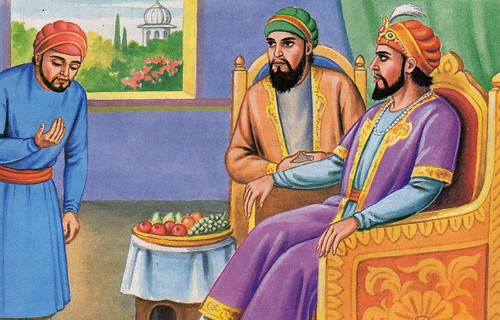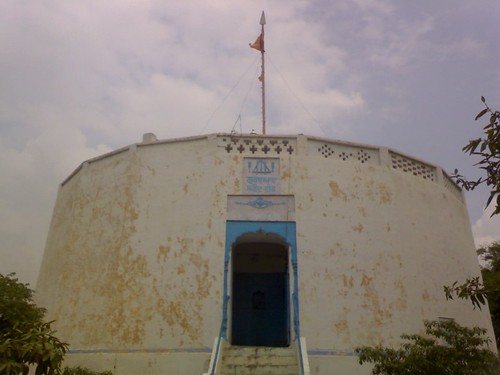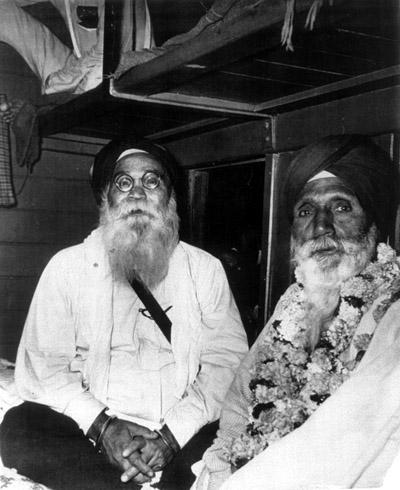Baba Palla JiTaken from Tapoban.org
Sri Guru Hargobind Sahib & The Limitless Langar
Taken from “Nau Visheshtaiyaan Sri Sukhmani Sahib jee” by Bhai GurIkbaal Singh
Bibi SantiDuring the time of Guru Hargobind Sahib, there was a Sikh woman, Bibi Santi, who was married into a family in the village of Butala. Bibi Santi’s parents were Sikhs but due to circumstances, she found herself married into a family that believed in Sakhi Sarvar (a Muslim Pir). Bibi Santi read Gurbani daily and had a deep love for the Guru. Her mother-in-law however, could not tolerate this faith in Sikhi. Eventually, Bibi Santi was asked to leave the family’s house and was made to live in a hut outside.
Bibi Santi was happy that now she would be able to read Gurbani without anyone objecting. Slowly she was able to influence her husband through stories of the Guru and he too became a Sikh.
After some time, a son was born to Bibi Santi who was named Palla. The happiness in the small family was short lived however as Bibi Santi’s husband died quite suddenly.
Faith in Satguru JeeBibi Santi did not lose her faith and kept walking on the path of Gurmat. She taught her son stories of the Guru and also Gurbani. Bhai Palla too developed a love for the Guru and had a deep desire to one day have Guru Sahib’s darshan. He would ask his mother when Guru Sahib would come to them and Bibi Santi would reply, “Satguru jee is antarjami (all-knowing). Wherever his Sikhs remember him, he will certainly come to meet them.”
Young Bhai Palla now had a non-stop longing to cast his eyes on his Satguru. Bhai Palla was convinced that Guru Sahib would come to him and so he wanted to be ready for the moment. Though he and his mother were very poor, he decided the best offering he could give to Guru Sahib was guR (sugar-jaggery). Wherever he went, Bhai Palla carried the guR with him, tied in a cloth, not knowing when Guru Sahib would hear his ardaas and give his darshan.
DarshanBhai Palla’s ardaas day and night bore fruit one day. Guru Sahib arrived in village Butala with some Sikhs. All the villagers were followers of Sakhi Sarvar and so no one paid Guru Sahib any respect. Guru Hargobind Sahib and his Sikhs however went directly to where Bhai Palla was sitting and stopped their horse in front of him. Bhai Palla recognized that his Satguru had finally come and was overjoyed. He remembered the guR he had tied in the cloth and began to fumble with the knot so he could offer it to Guru jee. Bhai Palla tried, but could not open the long-tied knot. Sri Guru Hargobind Sahib cast his loving eye on his Sikh and said, “Palla! Here, let me open your knots…”
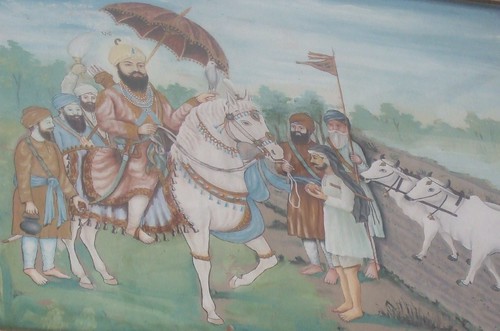
What a blessing Guru Sahib gave to Bhai Palla. What more could Bhai Palla ask?
Guru Sahib opened the knot and Bhai Palla humbly placed the guR before Guru Sahib and bowed. Satguru jee then said, “Palla! My Sikhs and I are hungry. Take us to your home and give us Langar.”
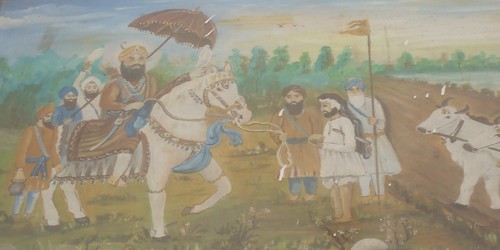
Bhai Palla could not contain his happiness and quickly lead Guru jee and the Sikhs to his small home. Mata Santi upon seeing Sri Guru jee’s darshan, lost all awareness. Bhai Palla shook his mother and said, “Guru Sahib wants to have Langar. Prepare Langar for him.”
Villagers and the LangarThe villagers of Butala were bitter and went on to their rooftops to see what was happening. They saw that Guru Sahib and his Sikhs were waiting for Langar and began to laugh that Bibi Santi and Bhai Palla who sometimes could not even manage one meal a day for themselves were now being asked to cook for so many. The villagers decided amongst themselves that no one would help the two Sikhs nor give them any loan to help buy rations for the Langar. They would see the humiliating scene when Bibi Santi and Bhai Palla would tell Guru Sahib that they could not make the Langar and have the opportunity to laugh at them.
Satguru Hargobind Sahib knew all and saw the crowds on their rooftops looking at them. Guru Sahib said to Bhai Palla, “Palla! Go invite all the villagers to have Langar here as well today.” Bhai Palla obeyed the hukam and went to all the villagers and asked them to come to their home for Langar. The villagers laughed and said that today the humiliation would be double what they expected. The mother and son could hardly feed themselves let alone all the Sikhs and now all the villagers.
The MiracleGuru Hargobind Sahib called Bhai Palla and gave him two kerchiefs and told him to put one on the flour and one on the daal. Mata Santi should not look underneath them after that.
Bibi Santi had prepared all the flour in the house for parshadas but it was still very little. There was also a little daal she had prepared. The two kerchiefs were placed on each and Bibi Santi began to prepare the parshadas while Bhai Palla did the seva of distributing them. To their amazement, all the Sikhs and all the villagers had their fill of Langar and still the parshadas and daal under Guru Sahib's kerchiefs were not finishing.
The villagers were awe-struck and fell at Guru Hargobind Sahib’s feet. They had wanted to see the humiliation of the two poor Sikhs but Guru Sahib had shown that he would never let his Sikhs be humiliated in such a way. The faith of the villagers in Sikhi was born that day and Bibi Santi and Bhai Palla’s faith was rewarded.
Baba Palla Ji is an ancestor of Dass.
 ਸਤਿਗੁਰਬਚਨਕਮਾਵਣੇਸਚਾਏਹੁਵੀਚਾਰੁ॥
ਸਤਿਗੁਰਬਚਨਕਮਾਵਣੇਸਚਾਏਹੁਵੀਚਾਰੁ॥

 ਸਤਿਗੁਰਬਚਨਕਮਾਵਣੇਸਚਾਏਹੁਵੀਚਾਰੁ॥
ਸਤਿਗੁਰਬਚਨਕਮਾਵਣੇਸਚਾਏਹੁਵੀਚਾਰੁ॥

